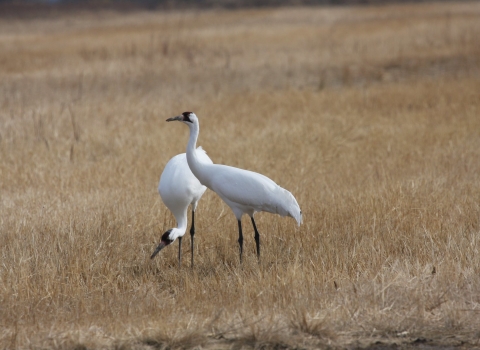Draft Economic Analysis Available for Proposed Revision of Spreading Navarretia Critical Habitat
Carlsbad, CA – The U.S. Fish and Wildlife Service (Service) announced today the availability of the draft economic analysis (DEA) for the June 10, 2009, proposal to revise critical habitat for Navarretia fossalis (spreading navarretia), a federally threatened plant in southern California. The Service is also proposing revisions and reopening the comment period on its proposed revised critical habitat rule.
Based on comments received, the Service reevaluated the proposed boundaries and made revisions to Subunits 1A, 1B, 3B, 5C, 5I, 6A, 6B, and 6C consisting of either the addition or removal of proposed critical habitat lands. These changes result in an overall increase of approximately 737 acres from the 6,872 acres proposed as critical habitat in June 2009.
In addition to lands considered for exclusion in the June 2009, proposed rule, the Service is also considering excluding a portion of land (51 acres) located within Subunit 4E that is part of the Ramona Grasslands Preserve. Of the 135 acres proposed in Subunit 4E, 51 acres are covered by a conservation easement conservation easement
A conservation easement is a voluntary legal agreement between a landowner and a government agency or qualified conservation organization that restricts the type and amount of development that may take place on a property in the future. Conservation easements aim to protect habitat for birds, fish and other wildlife by limiting residential, industrial or commercial development. Contracts may prohibit alteration of the natural topography, conversion of native grassland to cropland, drainage of wetland and establishment of game farms. Easement land remains in private ownership.
Learn more about conservation easement and management plan that provide a benefit for spreading navarretia and its habitat.
The DEA describes both baseline and incremental impacts associated with the areas proposed as critical habitat. Baseline impacts represent costs associated with listing under the ESA and other conservation efforts and are expected to range from $30.1 to $123.5 million over the next 20 years using a seven percent discount rate. Incremental impacts are estimated to be $846,000 to $1.2 million based on the same timeframe and discount rate and attributed solely to the designation of critical habitat for costs associated with the administration of conservation consultations.
Comments and information on the draft economic analysis and on all aspects of the proposed revised critical habitat rule, may be submitted electronically to http://www.regulations.gov, or in writing to: Public Comments Processing, Attn: FWS-R8-ES-2009-0038; Division of Policy and Directives Management, U.S. Fish and Wildlife Service, 4401 N. Fairfax Drive, Suite 222, Arlington, VA 22203. Comments will be accepted until May 17, 2010 and posted on http://www.regulations.gov.
A copy of the draft economic analysis and changes to the proposal to revise critical habitat for spreading navarretia are available online today at Federal Register Public Inspection, but do not include maps. The official copy, including maps, will be posted on April 15, 2010, at http://www.regulations.gov, at www.fws.gov/Carlsbad, or by contacting the Carlsbad Fish and Wildlife Office at 760-431-9440.
The mission of the U.S. Fish and Wildlife Service is working with others to conserve, protect and enhance fish, wildlife, plants and their habitats for the continuing benefit of the American people. We are both a leader and trusted partner in fish and wildlife conservation, known for our scientific excellence, stewardship of lands and natural resources, dedicated professionals and commitment to public service. For more information on our work and the people who make it happen, visit www.fws.gov/
-FWS-


